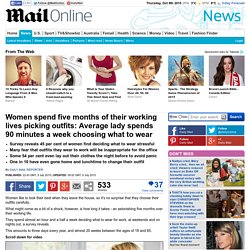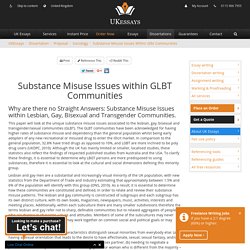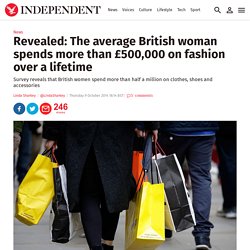

Collins English Dictionary. Collins English Dictionary. Style. Women spend five months of their working lives picking outfits. Survey reveals 45 per cent of women find deciding what to wear stressfulMany fear that outfits they wear to work will be inappropriate for the officeSome 54 per cent even lay out their clothes the night before to avoid panicOne in 10 have even gone home and lunchtime to change their outfit By Daily Mail Reporter Published: 22:43 GMT, 5 July 2015 | Updated: 09:52 GMT, 6 July 2015 Women like to look their best when they leave the house, so it's no surprise that they choose their outfits carefully.

What might come as a bit of a shock, however, is how long it takes - an astonishing five months over their working life. They spend almost an hour and a half a week deciding what to wear for work, at weekends and on nights out, a survey reveals. This amounts to three days every year, and almost 20 weeks between the ages of 18 and 65. Scroll down for video Stress: The average woman spends almost an hour and a half every week trying to decide what to wear for work, at weekends and on nights out. Substance Misuse Issues within GLBT Communities. Why are there no Straight Answers: Substance Misuse Issues within Lesbian, Gay, Bisexual and Transgender Communities.

This paper will look at the unique substance misuse issues associated to the lesbian, gay, bisexual and transgender/sexual communities (GLBT). The GLBT communities have been acknowledged for having higher rates of substance misuse and dependency than the general population whilst being early adopters of any new recreational or misused drug to enter the illicit market. In comparison to the general population, 32.8% have tried drugs as opposed to 10%, and LGBT are more inclined to be poly drug users (UKDPC, 2010).
Although the UK has mainly limited or smaller, localised studies, these statistics also reflect the findings of respected published studies from Australia and the USA. Gay men and lesbians have through their sexual orientation, self identified themselves as a sexual minority. Related Content. Facts and Figures in the UK fashion industry - statistics about the fashion business in England - size of economic activities. Archive: Fashion industry statistics United Kingdom 14 February 2014 At a press conference to open London Fashion Week Natalie Massenet, Chairman of the British Fashion Council, announced updated figures showing substantial growth in the UK fashion industry over the past five years. - The direct value of the UK fashion industry to the UK economy is £26 billion; up from £21 billion in 2009.

Showing an increase of 22% in nominal terms (source: Oxford Economics 2014) - The UK fashion industry is estimated to support 797,000 jobs (source: Oxford Economics 2014). This is a decrease of 2.3% from 2009 - Whilst employment figures have dropped overall the increased contribution to UK GVA reflects higher productivity within the fashion sector. The Mayor of London Boris Johnson said: ‘These latest figures are clear evidence of the hugely important contribution that fashion makes to our economy. In 2009 there were 293,510 retail outlets in the UK. Revealed: The average British woman spends more than £500,000 on fashion over a lifetime. A new survey has revealed that an average British woman will spend more than half a million pounds on fashion over a lifetime.

Britain’s fashion industry is worth £26 billion to the economy –- and with the results of a research of British women's spending habits released this week, it’s no wonder why. The poll by British online designer re-sale Covetique.com of 1,100 women aged between 30 and 45 discovered an average spend of £1,200 per month on clothes, shoes and accessories that equals a month's rent of a one-bedroom flat in London. Over the course of 50 adult years that adds up to the staggering amount of £720,000. It sounds like a vast sum, but 70 per cent of those surveyed didn’t know about the wealth hidden in their wardrobes, but they all admitted that over 50 per cent of their clothing involves designer garments.
Despite some of the wardrobes being worth the same amount as a Ferrari, only about 20 per cent of these closets have been insured. Diane von Furstenberg autumn/winter 2014. Retailing in the United Kingdom. A steady but unspectacular year for retailing Retailing in the UK registered an increase in 2014, with slightly improved economic conditions helping retailers to achieve some growth.

However, once again growth was hardly spectacular – retailers had to work hard to convince shoppers to part with their money. A slightly more positive economic outlook is expected for the forecast period, encouraging a slow recovery in consumer spending in a number of retail channels. The influence of technology on all areas of retailing increases Technology continues to be the catalyst for growth in retailing in the UK. Grocery retailers struggle, whilst non-grocery offers some hope The big four grocery retailers – Tesco, Sainsbury’s, Asda and Morrisons – all struggled over the course of 2014.